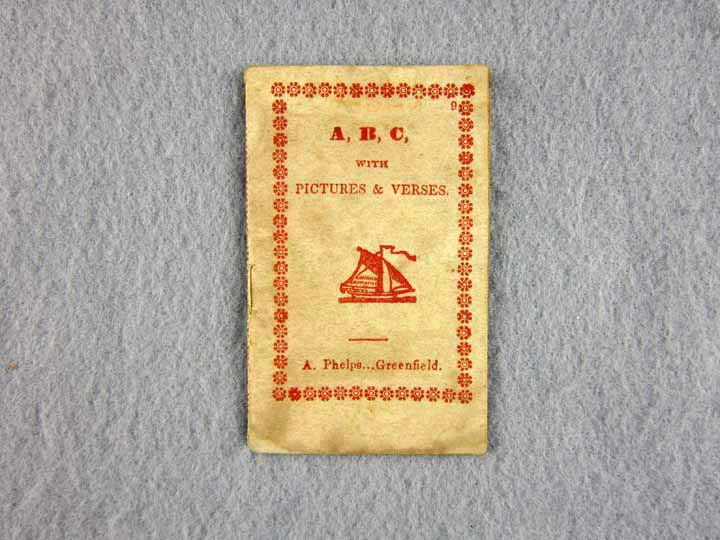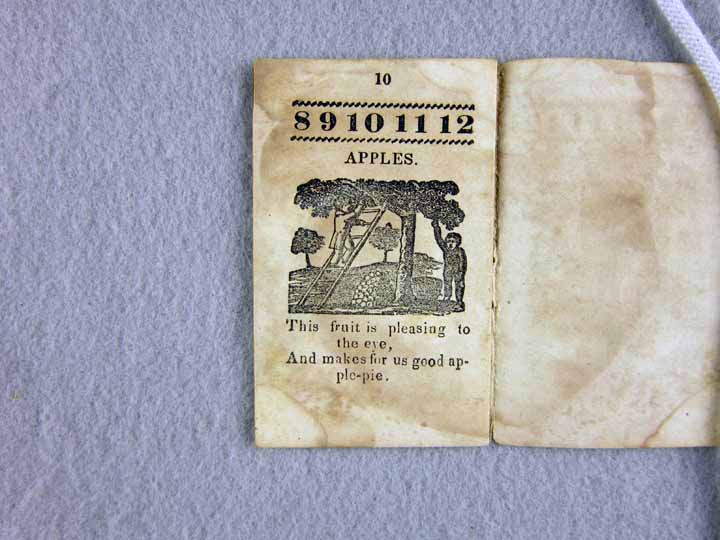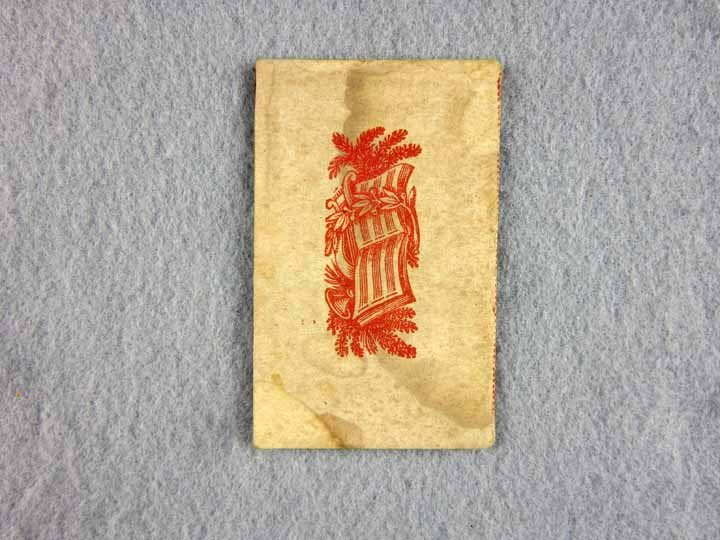

Alphabet books offer a vivid insight into the history of literacy and culture, as well as concepts of childhood. The Children's Book Collection at UCLA contains a rich array of these materials, some well-worn and much-used, some still bright and fresh. Each is a gem of print production and graphical imagery from another time and place. Though the history of alphabet books continues to the present, this exhibit focuses on the works in our collections published between 1700 and 1900, including horn books, primers, works of didacticism and seriousness, whimsy and play.
2. A Jumble ABC
3. A Little Pretty Pocket-Book
4. A New Lottery Book of Birds And Beasts
5. A Pretty Play-Thing for Children of All Denominations
8. ABC of Objects for Home And School
10. ABC with Pictures & Verses
12. Alphabet Et Instruction Pour Les Enfans
16. Dolly's ABC Book
17. Flora's ABC
18. Home ABC
22. Hornbook C. 1700
23. Large Letters for the Little Ones
24. Little ABC Book
25. Little People: An Alphabet
26. Martin's Nursery Battledoor
27. Mother Goose ABC
28. My Darling's ABC
29. Orbis Sensualium Pictus Quadrilinguis
30. People of All Nations: A Useful Toy for Girl Or Boy
31. Picture Alphabet
32. Pretty ABC
33. Railway ABC
34. Rusher's Reading Made Most Easy
38. The Alphabet of Old Friends
40. The Amusing Alphabet for Young Children Beginning To Read
42. The Child's Christian Education
45. The Easter Gift
47. The Favorite Alphabet for the Nursery
49. The Franklin Alphabet And Primer
51. The Golden ABC
55. The Moral And Entertaining Alphabet
57. The Old Testament Alphabet
59. The Picture Alphabet for Little Children
62. The Sunday ABC
63. The Union ABC
64. The Young Child's ABC, Or, First Book
65. Tom Thumb's Alphabet: Picture Baby-Books
67. Warne's Alphabet And Word Book: with Coloured Pictures
68. Wood's Royal Nursery Alphabet
Title ABC with Pictures & Verses



Brief description Short 10 pg. with Alphabet on top and pictures of animals with Caps on top and lower case on bottom. Picture is in middle with verse. The last two pages include the numbers 1-10 on the top, punctuation on bottom of page 9. Page 8 bottom Is the joined Latin(?) letters. Excellent quality. Printing is of a higher quality In addition to being the only book with pictures there are designs along the sides of pages and framing the breaks between letters and images. Suggests a higher class as the music and quality of the print are high even though it's so small. Perhaps the book was created to be distributed to wealthy patrons for their children, which simultaneously displaying the quality of the printing craftsmanship. Also has cute rhyme on the last page involving apples and pie.Finely folded and stitched spine (may have been redone later).
Full description A, B, C, with Pictures & Verses is an example of finely detailed print work produced in early America.
The back displays an open book of music with instruments in the background: a horn and a harp with whimsical branches of flowers surrounding it. The book also contains the images of pastoral settings as well as industry, as suggested by the ship in front.
This ten page book is filled with designs along the sides of pages and framing the breaks between letters and images. This brings to mind a higher class user as the music and quality of the print are exceptional despite the diminutive size. There is an ephemeral quality suggesting that perhaps the book was created for distribution amongst wealthy patrons, while simultaneously displaying the quality of the printing craftsmanship.
Literacy By time of publication for this booklet, the idea of promoting literacy as well as its concept of childhood and the various ideals associated with children were fully accepted concepts in society. While this book was most likely intended for a child of higher social standing, the possible ephemeral quality of the item suggests that books had become so common that they could literally be thrown away or forgotten, at least by the higher class.
With the emergence of schools like Dame Schools and laws aimed at promoting a network of school systems, people in a wide range of social standings, including the lower class were more commonly able to provide their child with at least a basic understanding of literacy and simple arithmetic. While cultural trends may not have had the same impact on the higher classes as they did on the lower and middle, the attitudes regarding curriculum was steadily improving as society came to expect more knowledge in general from its population.
While the booklet is small, it is made with obvious craftsmanship and indicates that more consideration was taken for the materials that would gradually introduce a child to words and reading. Such consideration suggests that publishers were able to gear the tools of literacy for a specific audience member as a recipient, creating a more refined apparatus in order to properly convey knowledge.
This book in comparison to the books of the early 19th century clearly displays the public trend towards education and literacy steadily increasing.
Childhood Despite the slight size of this item, this small pamphlet was made with obvious care and attention to detail. When published in Greenfield, Massachusetts by A. Phelps in 1848, a specific demographic was targeted as evidenced by the cultural iconography on its pages.
The materials used are of a finer quality and there are also images on the front and back of the booklet which suggest a higher class background. The front displays a large ship while the back displays an open music book with instruments and flowers surrounding it, two images a child of wealth might be familiar with. The child using this booklet had access to a higher education, as there are alphabet rhymes and a little poem of on the last page of the booklet in addition to the alphabet.
Numbers and punctuation also run throughout the pages. The images themselves are a mix of both exotic and domesticated animals. The last page image however, is of two young children within an apple orchard. Their finer clothes and higher age illustrate the target audience the printer had in mind when the book was published.
This book is meant to entertain as it taught, which infers that the publishers are catering to the trend of entertainment as a means of education as Patricia Crain would have suggested in her book The Story of A. Yet the book is small, with only 10 pages and measuring only 83 mm, which suggests that this may have been considered ephemera at the time it was created.
Hence the child would have been socially familiar with the images of music and exotic animals, and wealthy enough to encounter high quality material. He or she would also have been old enough to enjoy the rhymes present in the booklet. Thus, despite a push for equality in literacy and education, the wealthier children were still given greater opportunities than those of the lower or middle class.
Iconography The culture of this book was one which included leisure and wealth. The materials used are of a finer quality; detailed and intricate woodcuts, higher quality ink which allowed such minute and intricate work without running or fading, and expertly cut pages carefully bound together. There are also images on the front and back of the booklet which suggest a higher class background.
The front displays a large ship while the back displays an open music book with instruments and flowers surrounding it, two images an affluent child might be familiar with. In particular the music not only suggests some luxury, but also entertainment and an awareness and appreciation for the arts. Indeed, the only images of children are finely dressed in a setting of rural tranquility, an idyllic scene which, if not recognizable from direct personal experience, is something which a child may imagine or fantasize about.
Production Despite the slight size of this item, this small pamphlet was made with obvious care and attention to detail. This shows considerable care was taken by the printmaker, which indicates a concerted effort to target the specific demographic likely to purchase such a small booklet.
The books small size is a strong indication that this piece may have been ephemeral, serving as a marketing tool of sorts to be given to a patron as a gesture of goodwill while simultaneously showing the considerable skill of the manufacturer as a whole. This level of sophistication is likely to be due to the then booming literacy market for children and children's educational tools, something that printers would be wise to consider and accommodate.
This is yet another indication of the gradual focus of the printing industry over time to accommodate a rising demand for not only children's books, but well made and colorful books geared towards engaging and relating to the child, therefore proving to be a more effective tool and justifiable purchase. While it comes in a small package, this little booklet is truly a triumph of both the printing and print world of the mid 1800's.
Publisher A. Phelps
Publication place Greenfield
Date 1848
UCLA Call Number CBC GR486 .A14 1848
Repository UCLA Charles E. Young Research Library, Dept. of Special Collections
Dimensions 83 mm
Technologies of production Printing
Caption